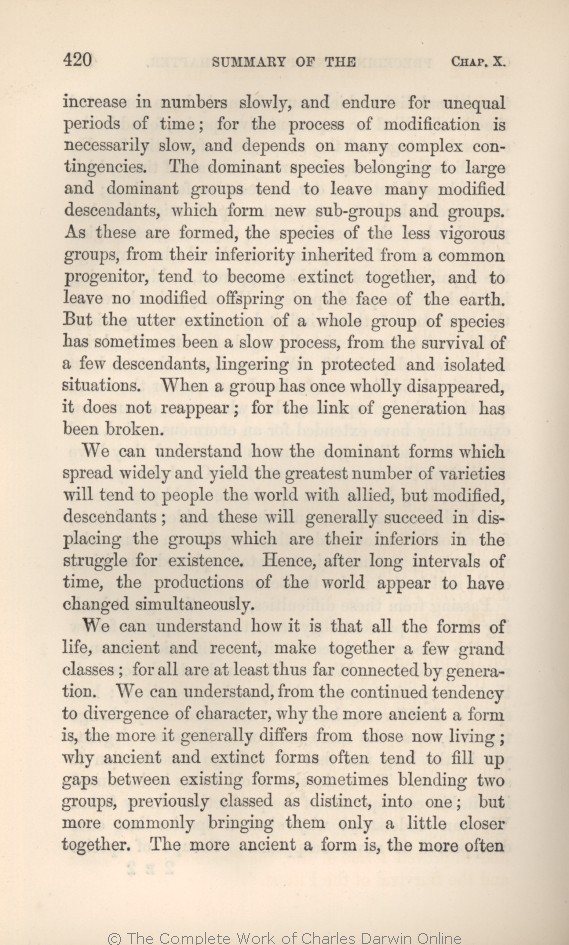increase in numbers slowly, and endure for unequal periods of time; for the process of modification is necessarily slow, and depends on many complex contingencies. The dominant species
belonging to large and | belonging to large and 1869 1872 |
| of the larger 1859 1860 1861 1866 |
| which form 1869 1872 | | and thus 1859 1860 1861 1866 |
| groups. 1869 1872 | | groups 1859 1860 1861 1866 |
| ..... 1869 1872 | | are 1859 1860 1861 1866 |
| ..... 1869 1872 | | formed. 1859 1860 1861 1866 |
| has sometimes been a 1866 1869 1872 |
| may often be a very 1859 1860 1861 |
|
|
We can understand how the
...| OMIT 1869 |
| spreading of the 1859 1860 1861 1866 |
| which spread widely and yield the greatest number of varieties will 1869 |
| of life, which are those that oftenest vary, will in the long run 1859 1860 1861 1866 |
| displacing 1869 | | taking 1859 1860 1861 1866 |
| groups 1869 |
| places of those groups of species 1859 1860 1861 1866 |
| ..... 1869 | | will 1859 1860 1861 1866 |
| simultaneously. 1859 1861 1866 1869 | | simultaneously. & 1860 |
|
|
We can understand how it is that
all the forms of life, ancient and recent, make together a few grand classes; for all are at least thus far connected by generation. | all the forms of life, ancient and recent, make together a few grand classes; for all are at least thus far connected by generation. 1869 |
| all the forms of life, ancient and recent, make together one grand system; for all are connected by generation. 1859 1860 1861 1866 |
| dominant forms which spread widely and yield the greatest number of varieties tend to people the world with allied, but modified, descendants; and these will generally succeed in displacing the groups which are their inferiors in the struggle for existence. 1872 |
| 1 blocks not present in 1859 1860 1861 1866 1869; present in 1872 | | Hence, after long intervals of time, the productions of the world will appear to have changed simultaneously.
|
| understand, 1859 1860 1861 1866 1869 | | understand 1872 |
| from 1859 1860 1861 1866 1869 |
| how it is that all the forms of life, ancient and recent, make together a few grand classes. We can understand, from 1872 |
| living; 1869 1872 |
| living. 1859 1860 1861 |
| living; why ancient and extinct forms often tend to fill up gaps between existing forms, sometimes blending two groups previously classed as distinct into one; but more commonly only bringing them a little closer together. 1866 |
| why 1869 1872 | | Why 1859 1860 1861 |
| groups, 1869 1872 | | groups 1859 1860 1861 |
| previously 1859 1860 1869 1872 | | previ- ously 1861 |
| distinct, 1869 1872 | | distinct 1859 1860 1861 |
| bringing them only 1869 1872 |
| only bringing them 1859 1860 1861 |
| often 1869 1872 | | often, 1859 1860 1861 1866 |
|









